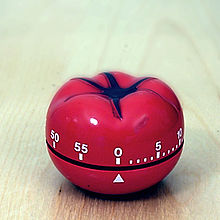Today I’m writing about how I’m trying to keep control of all the work stuff I have to do with a mix of the Things and Pomodorable OSX apps.
Things 1 and Things 2
Things 1 was a great OSX task management app by the German startup Cultured Code. It let you organise tasks in a very clean and simple way. It looked really nice too.
It did however come from an age (surprisingly only about 3 or 4 years ago) when iPhones were still novelties, iPads were just a crazy dream that people thought might end up being called iSlates, and cloud sharing services like Dropbox were really only just getting started. Syncing tasks between your MacBook’s copy of Things and your iPhone could only happen when they were on the same wifi network, and the whole process was generally pretty unsatisfactory.
Enter Things 2!

Cultured Code now provide a free cloud service with their revamped app. Now all your devices can work in harmony. The syncing in Things 2 is incredibly simple, and very fast. Even better Things hooks up to Mountain Lion’s Reminders app. Rather nice.

Things is one of those tools (both physical and digital) which are great to use because they just feel right. Of course simplicity of design belies a ton of effort and attention to detail behind the scenes, and it’s clear Cultured Code have done exactly that here. It makes to-do lists fun! Well, no. But almost. It’s that good.
Tomato (tuh-mah-toh)
“Who Knows Where the Time Goes?” sang the great Sandy Denny. Indeed. While in real life there may be a certain poignancy to this sentiment, at work time is money and it all has to be accounted for.
Managing your time on all those daily tasks and to-do lists can be tricky. Distractions and interruptions aren’t necessarily a bad thing if they produce results, but they don’t get you any nearer the end of the task you were originally working on. You can end up wondering what exactly it was that you achieved after what seemed like a pretty full day of toil. That’s not the best feeling.
The Web Development team at Kent uses a Scrum development methodology. A daily review of where you were, where you are, and where you’re going really helps give some focus. But in addition to this, a tool I’ve found helpful is The Pomodoro Technique®. Yes, it needs that little ® because it’s protected by US law, and you can buy all kinds of official certificates and merchandise thanks to that.
But the principle behind it is incredibly simple: focussing on a task is something people can only manage effectively for half an hour or thereabouts. Multi-tasking may seem like a good idea but it really only lets you do lots of things badly. If you want to get the job done, get the job done. It’s Apple vs Microsoft. It’s a simple and tasty dish vs food with too many conflicting tastes. It’s a simple effective web site vs a large rambling one. Focus is key to success.
 The practicalities of Pomodoro are simple:
The practicalities of Pomodoro are simple:
- Get a timer (it doesn’t have to be one of those tomato shaped timers but that was the inspiration for the technique’s name) and set it to 25 minutes.
- Focus on your task till the bell rings. Then take a 5 minute break. This is a pomodoro.
- Every 4 pomodoros take a longer 15 minute break.
- If you get interrupted in the middle of the pomodoro, either deflect the interruption or start the pomodoro again. This isn’t a rule to make life hard for yourself. The point, really, is to highlight distractions and thereby give you some control over them.
So does the technique work for everyone in all situations? Well, possibly not. Some tasks involve lots of interruptions by their very nature. But highly focussed things like reading, writing, and coding do lend themselves well.
Pomodorable
Accepting that the techinque does help and you want to use it, how to tie it up with tasks in Things? I’ve tried different apps, but none seemed great.
![]()
Pomodorable is a brand new app – good in its own right, and a great partner to Things. It looks lovely, and syncs well with Things (although I have had some issues with it not syncing fast).
You can set how long (in pomodoros) you want to allocate to a task by tagging it in Things e.g. “1 pom” or “3 pomodoros”, etc. This . This flows through to Pomodorable so you can keep track of how long you planned to spend on something as you progress through the pomodoros.
Paper and stopwatch?
So, you say: why not just write tasks on a bit of paper and time them with a watch? Fair enough.
But Things 2 and Pomodorable for me do have the advantage that you can create and edit tasks on your iPhone or iPad wherever you are. The way they also integrate with Apple’s Reminders is very nice. And unlike bits of paper that get lost, I’ve got a record all in one place of how long I spent on my tasks, all listed by day, project, tag, etc.
There are things that are missing. Graphs and spreadsheets keep managers happy, and it would be good to get some kind of export from Things 2 and Pomodorable so you can see clearly how long you planned to spend vs how long you actually spent. Team cooperation is possible if you use a shared email address and password, but there’s no real provision for roles and permissions and team-like stuff. Things is definitely something geared toward personal use.
All in all as a personal task management tool Things 2 is really nice, and the way it hooks up to Pomodorable provides some very lovey icing on a tasty cake. These tools are not the answer for everyone, but for me they do help keep track of the working day in a very simple way.
One response to “Controlling time with things and tomatoes (Things2 and Pomodorable)”